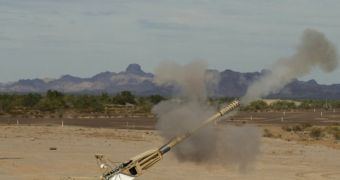Sandia National Laboratories in California are engaged in the development of a new high-caliber self-propelled and lightweight canon system, for the US Army. It's the most advanced program for designing a state-of-the-art canon.
Currently, the US Army uses more than twenty types of self-propelled canons and most applications are being used as anti-aircraft guns or as support for the infantry and mechanized units. The 8 inch (203 mm) Self-Propelled Howitzer M110 was the largest available self-propelled howitzer in the inventory.
The new weapon system, currently under development is known as the Non-Line-of-Sight Cannon (NLOS Cannon) and will be the most impressive of its kind ever designed. It will be fully automated and able to fire at a sustained rate of six rounds per minute.
The Army wants this new vehicle to be lightweight and agile enough, so that three of them will fit onto a C-17 cargo aircraft, used for delivery on the battlefield. Sandia is working on a critical adjustment to a laser ignition system that serves as the heart of the NLOS-Cannon vehicle.
Part of the Future Combat Systems (FCS), a modernization program for the US Army, the cannon will be the result of a collaboration between BAE systems and Sandia, a National Nuclear Security Administration laboratory.
"The laser ignition system offers much better precision, rapid fire, and automation than the mechanical method, and it's safer," says researcher Nipun Bhutani, who serves as project manager for the lab's NLOS-Cannon. "But it's obviously not going to be an effective long-term solution if reliability cannot be maintained."
Missions will include general support, counterbattery fire and suppression of enemy air defense systems and its range will be greater than 30 kilometers (19 miles).
The earliest known use of weapons specifically made for the anti-aircraft role occurred during the Franco-Prussian War of 1870. After the disaster at Sedan, Paris was besieged and French troops outside the city started an attempt to resupply via balloon. Krupp quickly modified a 1-pounder gun to be mounted on top of a horse-drawn carriage for the purpose of shooting down these balloons. Very little information on this weapon has been published.

 14 DAY TRIAL //
14 DAY TRIAL //